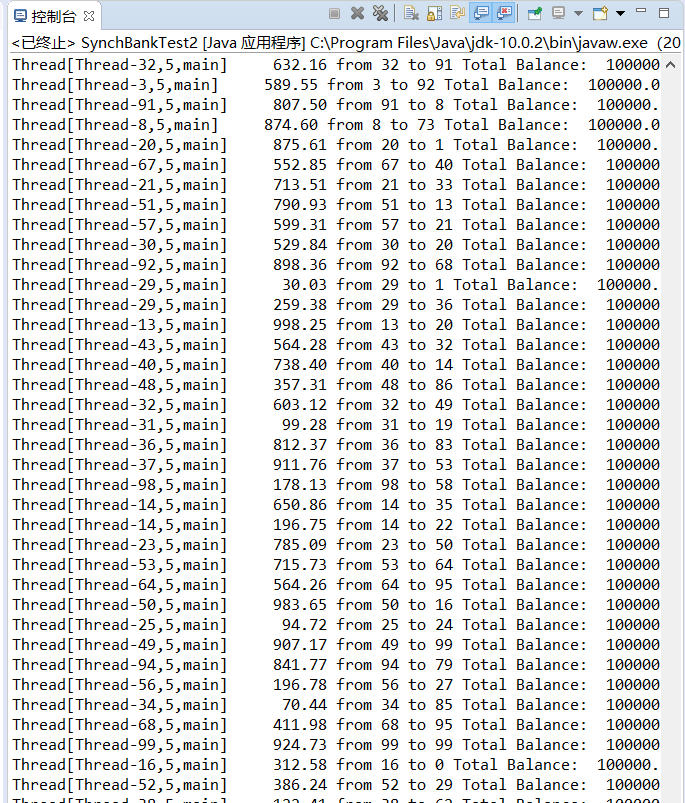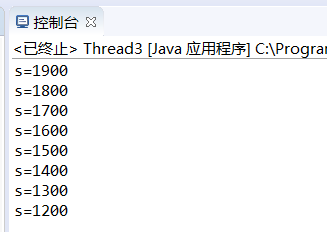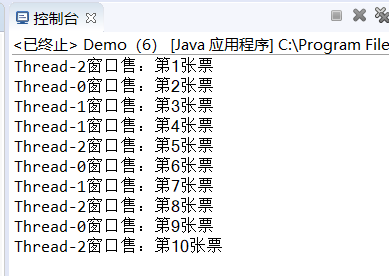达拉草201771010105《面向对象程序设计(java)》第十七周学习总结
达拉草201771010105《面向对象程序设计(java)》第十七周学习总结
第一部分:理论知识
1.多线程的概念:
(1)多线程是进程执行过程中产生的多条执行线索。
(2)多线程意味着一个程序的多行语句可以看上去几 乎在同一时间内同时运行。
(3)线程不能独立存在,必须存在于进程中,同一进 程的各线程间共享进程空间的数据。
Java实现多线程有两种途径:
创建Thread类的子类
在程序中定义实现Runnable接口的类
用Thread类的子类创建线程:
(1)首先需从Thread类派生出一个子类,在该子类中 重写run()方法。
例: class hand extends Thread {
public void run() {……}
}
(2) 然后用创建该子类的对象
Lefthand left=new Lefthand();
Righthand right=new Righthand();
(3)最后用start()方法启动线程
left.start();
right.start();
用Thread类的子类创建多线程的关键性操作:
(1)定义Thread类的子类并实现用户线程操作,即 run()方法的实现。
(2)在适当的时候启动线程。
由于Java只支持单重继承,用这种方法定义的类不 可再继承其他父类。
用Runnable()接口实现线程
(1)首先设计一个实现Runnable接口的类;
(2) 然后在类中根据需要重写run方法;
(3)再创建该类对象,以此对象为参数建立Thread 类的对象;
(4)调用Thread类对象的start方法启动线程,将 CPU执行权转交到run方法。
被阻塞线程和等待线程
blocked (被阻塞):
阻塞时线程不能进入队列排队,必须等到引起 阻塞的原因消除,才可重新进入排队队列。
sleep(),wait()是两个常用引起线程阻塞的方法。
线程阻塞的三种情况:
(1)等待阻塞 :通过调用线程的wait()方法,让线 程等待某工作的完成。
(2)同步阻塞 :线程在获取synchronized同步锁失 败(因为锁被其它线程所占用),它会进入同步阻 塞状态。
(3)其他阻塞 :通过调用线程的sleep()或join() 或发出了I/O请求时,线程会进入到阻塞状态。当 sleep()状态超时、join()等待线程终止或者超 时、或者I/O处理完毕时,线程重新转入就绪状态。
被终止的线程
Terminated (被终止) 线程被终止的原因有二:
(1)一是run()方法中最后一个语句执行完毕而自 然死亡。
(2)二是因为一个没有捕获的异常终止了run方法 而意外死亡。
可以调用线程的stop 方 法 杀 死 一 个 线 程 (thread.stop();),但是,stop方法已过时, 不要在自己的代码中调用它。
其他判断和影响线程状态的方法:
(1)join():等待指定线程的终止。
(2)join(long millis):经过指定时间等待终止指定 的线程。
(3)isAlive():测试当前线程是否在活动。
(4)yield():让当前线程由“运行状态”进入到“就 绪状态”,从而让其它具有相同优先级的等待线程 获取执行权。
多线程调度
(1)Java提供一个线程调度器来监控程序启动后进入可运行状态的所有线程。线程调度器按照线程的优先级决定应调度哪些线程来执行。
(2)处于可运行状态的线程首先进入就绪队列排队等候处理器资源,同一时刻在就绪队列中的线程可能有多个。Java的多线程系统会给每个线程自动分配一个线程的优先级。
Java 的线程调度采用优先级策略:
(1)优先级高的先执行,优先级低的后执行;
(2)多线程系统会自动为每个线程分配一个优先级,缺省时,继承其父类的优先级;
(3)任务紧急的线程,其优先级较高;
(4)同优先级的线程按“先进先出”的队列原则;
守护线程
守护线程的惟一用途是为其他线程提供服务。例 如计时线程。
在一个线程启动之前,调用setDaemon方法可 将线程转换为守护线程(daemon thread)。 例如: setDaemon(true);
实验十七 线程同步控制
实验时间 2018-12-10
1、实验目的与要求
(1) 掌握线程同步的概念及实现技术;
(2) 线程综合编程练习
2、实验内容和步骤
实验1:测试程序并进行代码注释。
测试程序1:
l 在Elipse环境下调试教材651页程序14-7,结合程序运行结果理解程序;
l 掌握利用锁对象和条件对象实现的多线程同步技术。
package synch; import java.util.*;
import java.util.concurrent.locks.*; /**
* A bank with a number of bank accounts that uses locks for serializing access.
* @version 1.30 2004-08-01
* @author Cay Horstmann
*/
public class Bank
{
private final double[] accounts;
private Lock bankLock;
private Condition sufficientFunds; /**
* Constructs the bank.
* @param n the number of accounts
* @param initialBalance the initial balance for each account
*/
public Bank(int n, double initialBalance)
{
accounts = new double[n];
Arrays.fill(accounts, initialBalance);
bankLock = new ReentrantLock();
sufficientFunds = bankLock.newCondition();
} /**
* Transfers money from one account to another.
* @param from the account to transfer from
* @param to the account to transfer to
* @param amount the amount to transfer
*/
public void transfer(int from, int to, double amount) throws InterruptedException//当线程在活动之前或活动期间处于正在等待、休眠或占用状态且该线程被中断时,抛出该异常。
{
bankLock.lock();//加锁
try
{
while (accounts[from] < amount)//条件对象判断当前对象是否进入
sufficientFunds.await();//造成当前线程在接到信号或被中断之前一直处于等待状态。
System.out.print(Thread.currentThread());
accounts[from] -= amount;
System.out.printf(" %10.2f from %d to %d", amount, from, to);
accounts[to] += amount;
System.out.printf(" Total Balance: %10.2f%n", getTotalBalance());
sufficientFunds.signalAll();
}
finally
{
bankLock.unlock();//释放锁
}
} /**
* Gets the sum of all account balances.
* @return the total balance
*/
public double getTotalBalance()
{
bankLock.lock();
try
{
double sum = 0; for (double a : accounts)
sum += a; return sum;
}
finally
{
bankLock.unlock();
}
} /**
* Gets the number of accounts in the bank.
* @return the number of accounts
*/
public int size()
{
return accounts.length;
}
}
package synch; /**
* This program shows how multiple threads can safely access a data structure.
* @version 1.31 2015-06-21
* @author Cay Horstmann
*/
public class SynchBankTest
{
public static final int NACCOUNTS = 100;
public static final double INITIAL_BALANCE = 1000;
public static final double MAX_AMOUNT = 1000;
public static final int DELAY = 10; public static void main(String[] args)
{
Bank bank = new Bank(NACCOUNTS, INITIAL_BALANCE);
for (int i = 0; i < NACCOUNTS; i++)
{
int fromAccount = i;
Runnable r = () -> {
try
{
while (true)
{
int toAccount = (int) (bank.size() * Math.random());
double amount = MAX_AMOUNT * Math.random();
bank.transfer(fromAccount, toAccount, amount);
Thread.sleep((int) (DELAY * Math.random()));
}
}
catch (InterruptedException e)
{
}
};
Thread t = new Thread(r);
t.start();
}
}
}
运行结果如下:

测试程序2:
l 在Elipse环境下调试教材655页程序14-8,结合程序运行结果理解程序;
l 掌握synchronized在多线程同步中的应用。
package synch2; import java.util.*; /**
* A bank with a number of bank accounts that uses synchronization primitives.
* @version 1.30 2004-08-01
* @author Cay Horstmann
*/
public class Bank
{
private final double[] accounts; /**
* Constructs the bank.
* @param n the number of accounts
* @param initialBalance the initial balance for each account
*/
public Bank(int n, double initialBalance)
{
accounts = new double[n];
Arrays.fill(accounts, initialBalance);
} /**
* Transfers money from one account to another.
* @param from the account to transfer from
* @param to the account to transfer to
* @param amount the amount to transfer
*/
public synchronized void transfer(int from, int to, double amount) throws InterruptedException
{
while (accounts[from] < amount)
wait();
System.out.print(Thread.currentThread());
accounts[from] -= amount;
System.out.printf(" %10.2f from %d to %d", amount, from, to);
accounts[to] += amount;
System.out.printf(" Total Balance: %10.2f%n", getTotalBalance());
notifyAll();
} /**
* Gets the sum of all account balances.
* @return the total balance
*/
public synchronized double getTotalBalance()
{
double sum = 0; for (double a : accounts)
sum += a; return sum;
} /**
* Gets the number of accounts in the bank.
* @return the number of accounts
*/
public int size()
{
return accounts.length;
}
}
package synch2; /**
* This program shows how multiple threads can safely access a data structure,
* using synchronized methods.
* @version 1.31 2015-06-21
* @author Cay Horstmann
*/
public class SynchBankTest2
{
public static final int NACCOUNTS = 100;
public static final double INITIAL_BALANCE = 1000;
public static final double MAX_AMOUNT = 1000;
public static final int DELAY = 10; public static void main(String[] args)
{
Bank bank = new Bank(NACCOUNTS, INITIAL_BALANCE);
for (int i = 0; i < NACCOUNTS; i++)
{
int fromAccount = i;
Runnable r = () -> {
try
{
while (true)
{
int toAccount = (int) (bank.size() * Math.random());
double amount = MAX_AMOUNT * Math.random();
bank.transfer(fromAccount, toAccount, amount);
Thread.sleep((int) (DELAY * Math.random()));
}
}
catch (InterruptedException e)
{
}
};
Thread t = new Thread(r);
t.start();
}
}
}
运行结果如下:

测试程序3:
l 在Elipse环境下运行以下程序,结合程序运行结果分析程序存在问题;
l 尝试解决程序中存在问题。
|
class Cbank { private static int s=2000; public static void sub(int m) { int temp=s; temp=temp-m; try { Thread.sleep((int)(1000*Math.random())); } catch (InterruptedException e) { } s=temp; System.out.println("s="+s); } }
class Customer extends Thread { public void run() { for( int i=1; i<=4; i++) Cbank.sub(100); } } public class Thread3 { public static void main(String args[]) { Customer customer1 = new Customer(); Customer customer2 = new Customer(); customer1.start(); customer2.start(); } } |
class Cbank
{
private static int s=2000;
public static void sub(int m)
{
int temp=s;
temp=temp-m;
try {
Thread.sleep((int)(1000*Math.random()));
}
catch (InterruptedException e) { }
s=temp;
System.out.println("s="+s);
}
} class Customer extends Thread
{
public void run()
{
for( int i=1; i<=4; i++)
Cbank.sub(100);
}
}
public class Thread3
{
public static void main(String args[])
{
Customer customer1 = new Customer();
Customer customer2 = new Customer();
customer1.start();
customer2.start();
}
}
运行结果如下:

改进后的程序如下:
class Cbank
{
private static int s=2000;
public synchronized static void sub(int m)
{
int temp=s;
temp=temp-m;
try {
Thread.sleep((int)(1000*Math.random()));
}
catch (InterruptedException e) { }
s=temp;
System.out.println("s="+s);
}
} class Customer extends Thread
{
public void run()
{
for( int i=1; i<=4; i++)
Cbank.sub(100);
}
}
public class Thread3
{
public static void main(String args[])
{
Customer customer1 = new Customer();
Customer customer2 = new Customer();
customer1.start();
customer2.start();
}
}
运行结果如下:

实验2 编程练习
利用多线程及同步方法,编写一个程序模拟火车票售票系统,共3个窗口,卖10张票,程序输出结果类似(程序输出不唯一,可以是其他类似结果)。
Thread-0窗口售:第1张票
Thread-0窗口售:第2张票
Thread-1窗口售:第3张票
Thread-2窗口售:第4张票
Thread-2窗口售:第5张票
Thread-1窗口售:第6张票
Thread-0窗口售:第7张票
Thread-2窗口售:第8张票
Thread-1窗口售:第9张票
Thread-0窗口售:第10张票
public class Demo {
public static void main(String[] args) {
mythread mythread=new mythread();
Thread t1=new Thread(mythread);
Thread t2=new Thread(mythread);
Thread t3=new Thread(mythread);
t1.start();
t2.start();
t3.start();
}
}
class mythread implements Runnable{
int t=1;
boolean flag=true;
@Override
public void run() {
while(flag) {
try {
Thread.sleep(50);
}catch(InterruptedException e)
{
e.printStackTrace();
}
synchronized (this) {
if(t<=10) {
// TODO Auto-generated method stub
System.out.println(Thread.currentThread().getName() + "窗口售:第" + t + "张票");
t++;
}
if(t>10) {
flag=false;
}
}
}
}
}
运行结果如下:

实验总结:
本周学习了同步线程的相关问题,这也是我们最后一次实验,在这周的学习中我们学习了并发多线程,学习了锁对象、synchronized关键字等。
达拉草201771010105《面向对象程序设计(java)》第十七周学习总结的更多相关文章
- 201771010134杨其菊《面向对象程序设计java》第九周学习总结
第九周学习总结 第一部分:理论知识 异常.断言和调试.日志 1.捕获 ...
- 201871010132-张潇潇《面向对象程序设计(java)》第一周学习总结
面向对象程序设计(Java) 博文正文开头 项目 内容 这个作业属于哪个课程 https://www.cnblogs.com/nwnu-daizh/ 这个作业的要求在哪里 https://www.cn ...
- 扎西平措 201571030332《面向对象程序设计 Java 》第一周学习总结
<面向对象程序设计(java)>第一周学习总结 正文开头: 项目 内容 这个作业属于哪个课程 https://www.cnblogs.com/nwnu-daizh/ 这个作业的要求在哪里 ...
- 杨其菊201771010134《面向对象程序设计Java》第二周学习总结
第三章 Java基本程序设计结构 第一部分:(理论知识部分) 本章主要学习:基本内容:数据类型:变量:运算符:类型转换,字符串,输入输出,控制流程,大数值以及数组. 1.基本概念: 1)标识符:由字母 ...
- 201871010124 王生涛《面向对象程序设计JAVA》第一周学习总结
项目 内容 这个作业属于哪个课程 https://www.cnblogs.com/nwnu-daizh/ 这个作业的要求在哪里 https://edu.cnblogs.com/campus/xbsf/ ...
- 201871010115——马北《面向对象程序设计JAVA》第二周学习总结
项目 内容 这个作业属于哪个课程 https://www.cnblogs.com/nwnu-daizh/ 这个作业的要求在哪里 https://www.cnblogs.com/nwnu-daizh/p ...
- 201777010217-金云馨《面向对象程序设计(Java)》第二周学习总结
项目 内容 这个作业属于哪个课程 https://www.cnblogs.com/nwnu-daizh/ 这个作业的要求在哪里 https://www.cnblogs.com/nwnu-daizh/p ...
- 201871010132——张潇潇《面向对象程序设计JAVA》第二周学习总结
项目 内容 这个作业属于哪个课程 https://www.cnblogs.com/nwnu-daizh/ 这个作业的要求在哪里 https://www.cnblogs.com/nwnu-daizh/p ...
- 201771010123汪慧和《面向对象程序设计Java》第二周学习总结
一.理论知识部分 1.标识符由字母.下划线.美元符号和数字组成, 且第一个符号不能为数字.标识符可用作: 类名.变量名.方法名.数组名.文件名等.第二部分:理论知识学习部分 2.关键字就是Java语言 ...
- 达拉草201771010105《面向对象程序设计(java)》第三周学习总结
达拉草201771010105«面向对象程序设计(java)»第三周学习总结 第一部分:实验部分 1.实验目的与要求 (1)进一步掌握Eclipse集成开发环境下java程序开发基本步骤: (2)熟 ...
随机推荐
- Vue框架:挂载点-过滤器-事件指令-表单指令
近期学习安排 1.Vue框架 前台html+css+js框架,是不同于js与JQuery的数据驱动框架, 学习的知识点:指令 | 实例成员 | vue项目 2.drf框架 django的插件,完成前 ...
- Tokyocabinet/Tokyotyrant文档大合集
1. 前言 这里不是我个人原创,是我对网络上整理到的资料的再加工,以更成体系,更方便研究阅读.主要是对其中跟主题无关的文字删除,部分人称稍做修改;本人无版权,您可以将本页面视为对参考页面的镜像.第二部 ...
- PAT甲级——1061 Dating
1061 Dating Sherlock Holmes received a note with some strange strings: Let's date! 3485djDkxh4hhGE 2 ...
- 服务端向客户端推送消息技术之websocket的介绍
websocket的介绍 在讲解WebSocket前,我们先来看看下面这种场景,在HTTP协议下,怎么实现. 需求: 在网站中,要实现简单的聊天,这种情况怎么实现呢?如下图: 当发送私信的时候,如果要 ...
- java中==和equals
/** * @author zhaojiatao * @date 2018/7/19 */ public class equalsLearn { public static void main(Str ...
- nginx相关地址
http://www.nginx.cn/doc/ 中文文档 http://nginx.org/en/docs/ 英文文档 https://pan.baidu.com/s/1qWAZ ...
- jQuery实现button按钮提交表单
在JSP页面中,通常使用button按钮提交表单数据,使用jQuery实现代码如下: <span style="font-family:Comic Sans MS;font-size: ...
- Emgu.CV.CvInvoke的类型初始值设定项引发异常”TypeInitializationException”的问题
问题如图: 解决方案: 1.记住EmguCV的安装位置:X:\XXX\XXX… 本测试方案中EmguCV的安装位置:D:\Emgu,操作时记得用自己的EmguCV安装路径替换掉D:\Emgu. 2.添 ...
- Ubuntu gnome安装Monaco字体,FontForge module is probably not installed
首先下载原始Monaco字体,注意我只找到了这一款在ubuntu的gnome下可见,其他的各种monaco即使安装了也看不到. https://gist.github.com/epegzz/16342 ...
- JS Style Guide_1
当你在回调函数里要使用函数表达式时,尽量使用箭头函数,比如数组中的 Map.filter.reduce等的回调函数中 [1,2,3].map((x) => { let y = x + 1; re ...
